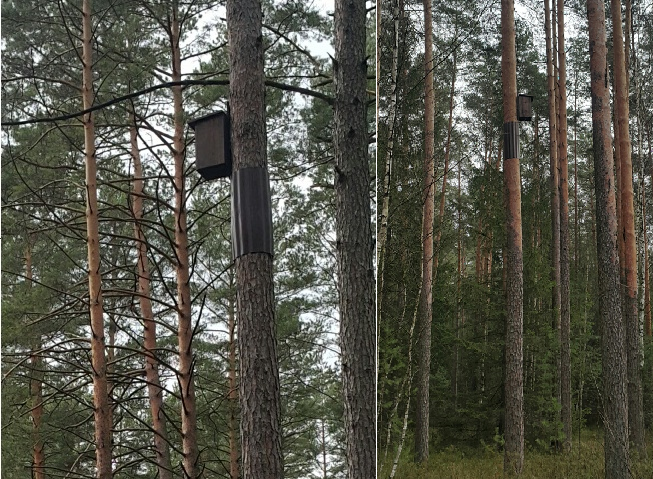|
New nesting boxes for boreal owls in the Solska Forest
At the time when the media was loud about the "Flat+" project, silently, in inaccessible locations within the Solska Forest and the Janów Forests, we completed the "Nesting box+" task, or, to use the project nomenclature, the "C5 Construction and installation of nesting boxes and protection against predators for the boreal owl" task. As part of the project implementation a total of 60 nesting boxes were made and installed for this lovable owl species within the forest divisions of Józefów, Zwierzyniec, Biłgoraj, Janów Lubelski and Narol. The nesting boxes were made of oak and painted to camouflage them, and then hung in those places where, during the inventory carried out as a part of the A2 task, territorial boreal owl males were identified. The nesting boxes were installed at a height of 10 metres and were protected from attacks by predatory mammals. At the end of 2015 and beginning of 2016, when the first batch of 30 nesting boxes was installed, we protected them by fitting a special ring of spikes around the trunk, as shown in the photographs below.
.jpg)
Unfortunately, during the spring monitoring of the installed nesting boxes, in spite of the protection used, in one of them we found traces of the presence of the European pine marten - a mammal species which forms one of the most serious threats to the boreal owl. However, part of the project implementation was to draw conclusions as soon as possible and to systematically introduce suitable methods of protection. As a result, while installing the second batch of protection systems we used a different kind, one made of a hard but flexible material - PVC. We hope that those martens wishing to penetrate a nesting box will be unable to overcome such an unnaturally slippery part of the trunk.

Abaut "zone" protection
Bird species included in our project, i.e. white-tailed eagle, lesser spotted eagle, Eurasian eagle-owl, short-toed snake eagle, black stork and boreal owl are scarce or extremely scarce breeding birds of our country. They are protected under national law and the recorded under Directive 2009/147/EC of the European Parliament and Council of 30 November 2009 on the conservation of wild birds, known as the Bird Directive. They are also subjected to strict protection and, additionally, their nesting sites are under protection as well, because around the nests occupied by them have two types of protection zones: year round and periodic.
The year-round protection zone, also called a strict protection zone, is an area excluded from human activity, functioning on the basis of the strict reserve. Its size is determined depending on the species. Access to the zone, as well as carrying out any activities in its area is possible only with the permission issued by the locally competent Regional Director of Environmental Protection.
The partially protected zone is an area temporarily excluded from human activity, usually surrounding the land subjected to strict protection. For bird species covered by the project, the boundary of partial protection zone is fixed at a radius of 500 m from the nest. The exception is boreal owl, for which this type of protection is not used. The periods when the restrictions in conducting activity in the area of the protection zone have effect vary depending on the species and cover the entire breeding season of such species.
Apart from the passive protection, carried out by creating the above described protection zones, the nests of the rarest bird species are more often actively protected. Building special nesting platforms is an example of such protection, realised within the framework of the project "Protection of rare zonal birds in selected areas of Natura 2000 in the Lublin region". They are solid constructions, made from natural materials that are firmly attached to trees. They provide the birds with an opportunity to build a solid nest which will safely serve their young, which will be brought up in it, for many seasons.
In our country, most of this types of constructions have been installed for osprey. They are also built for white-tailed eagle, golden eagle and greater spotted eagle. Black storks also benefit from the nesting platforms. Under a project by the Lublin Ornithological Society building such artificial nesting sites is planned for three bird species. This task is particularly important for the Eurasian eagle owl, which in the Lublin region often starts breeding on the ground, what unfortunately results in large losses due to the destruction of eggs or killing of the nestlings by wild boars or predatory mammals. In the case of lesser spotted eagle and black stork, platforms are installed for the nests situated on small and unstable trees, but near the convenient feeding grounds.
Another, often practiced form of direct protection of birds during nesting is the installation of nesting boxes. Within the project realization the installation of such substitutes of nesting sites for the boreal owl is planned. Previous experience has shown that for this species the effectiveness of such treatment is very high (the observations carried out in Norway demonstrated that this species even prefers using nesting boxes; 97% of 167 broods being found in nesting boxes). In young tree stands, where old hollow bearing trees are missing, nesting boxes are voluntarily inhabited, with additional protection in the form of special guards against martens installed on them, results in a significant increase in breeding success and thus, the expansion of the species.
|









